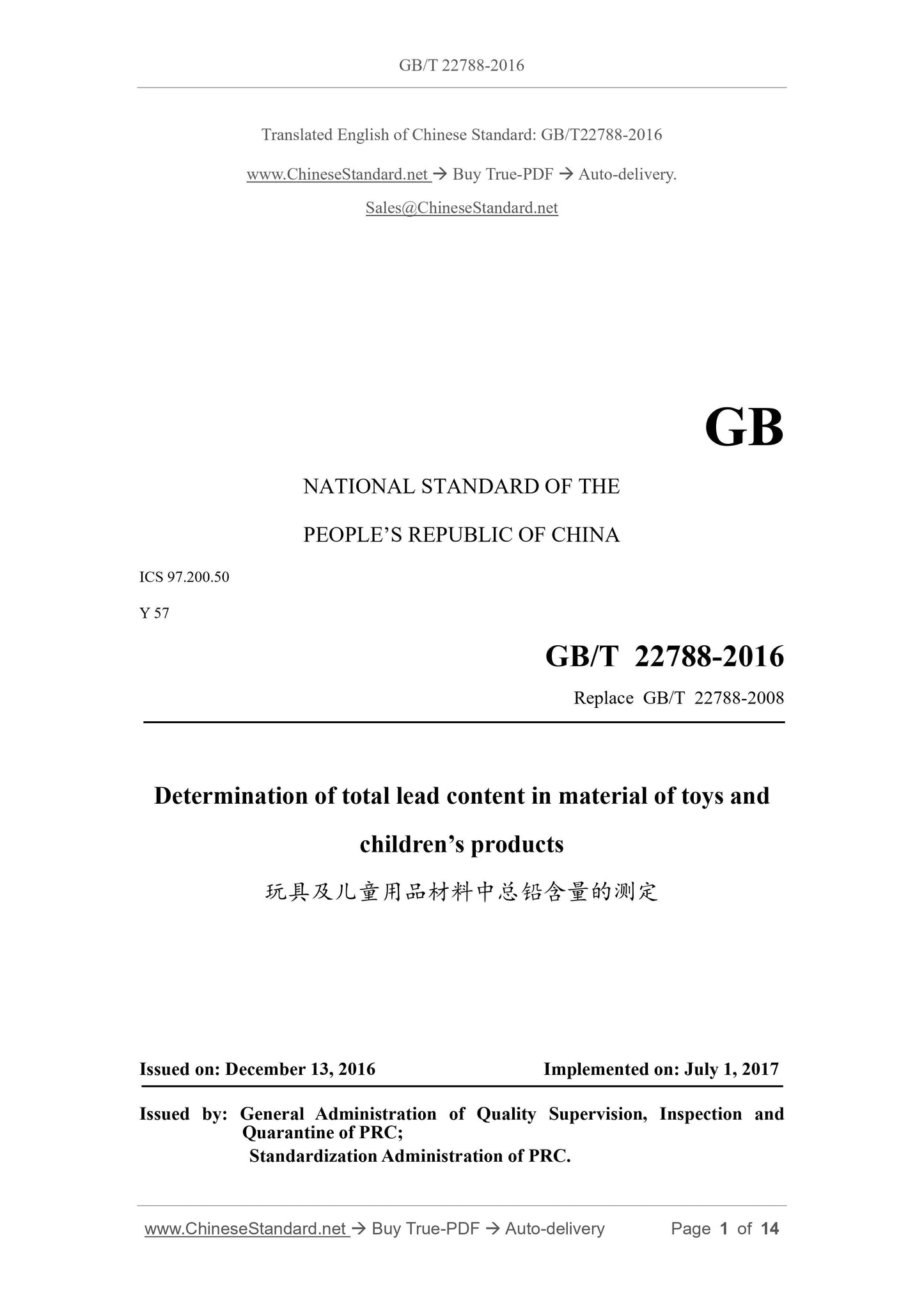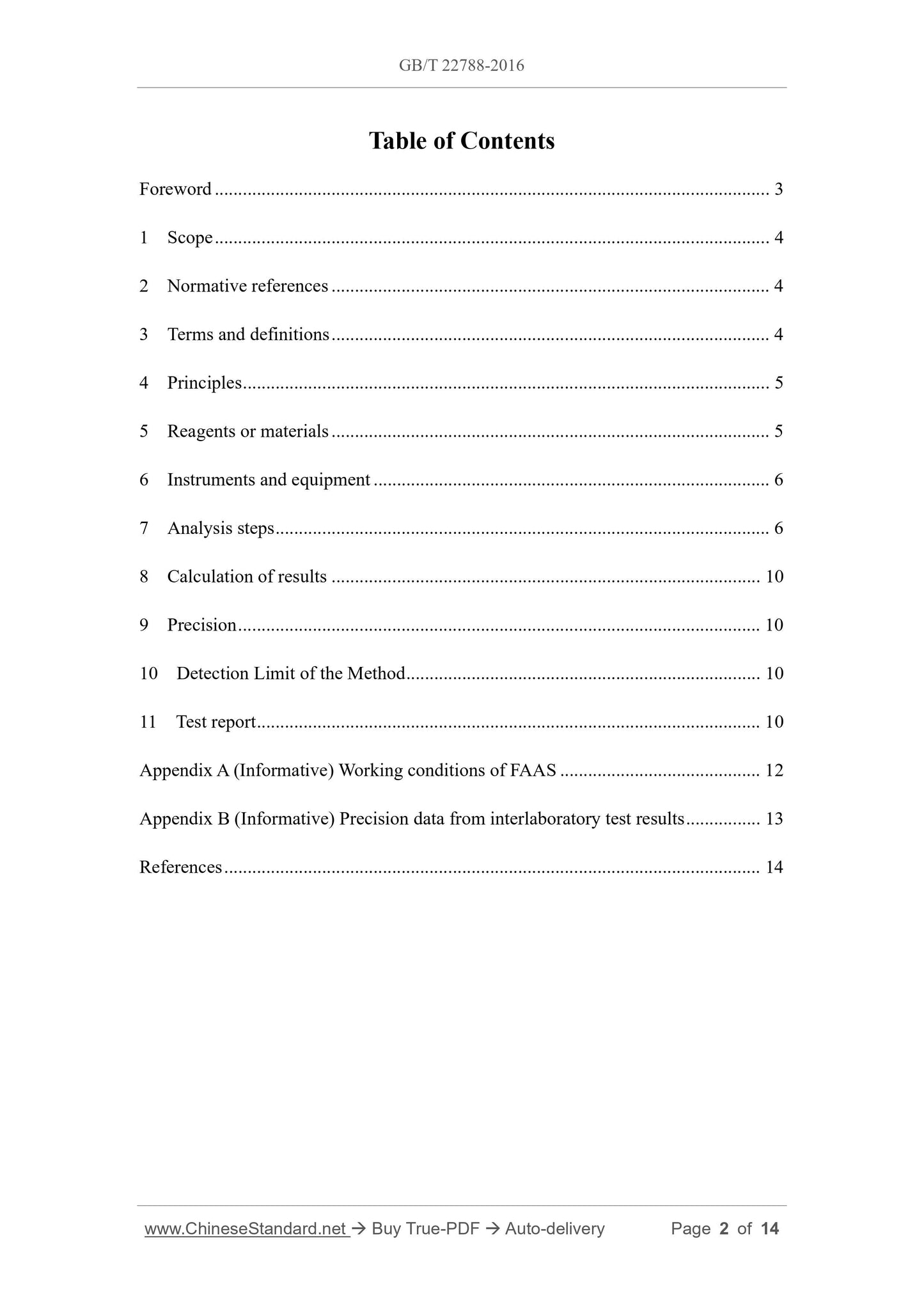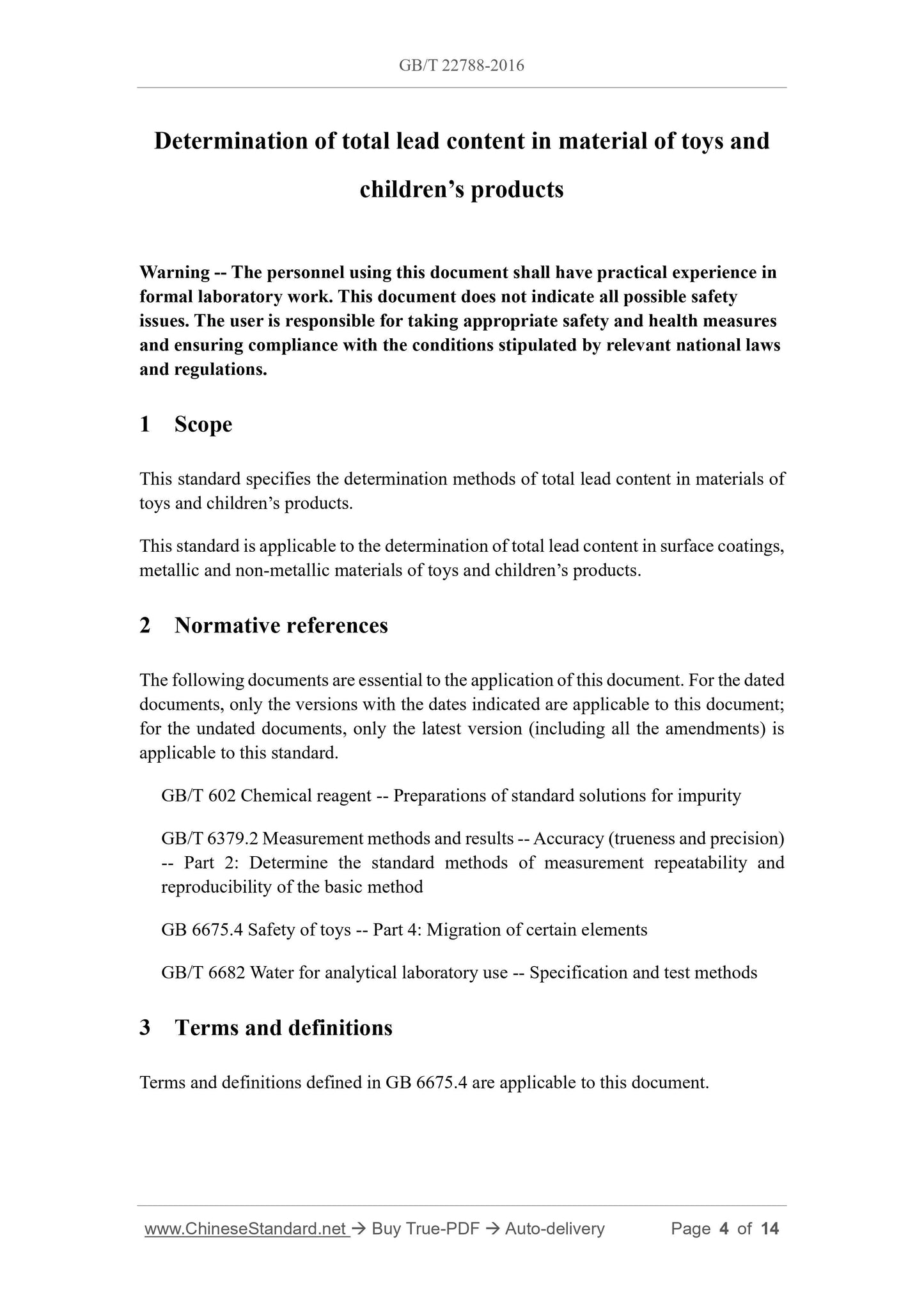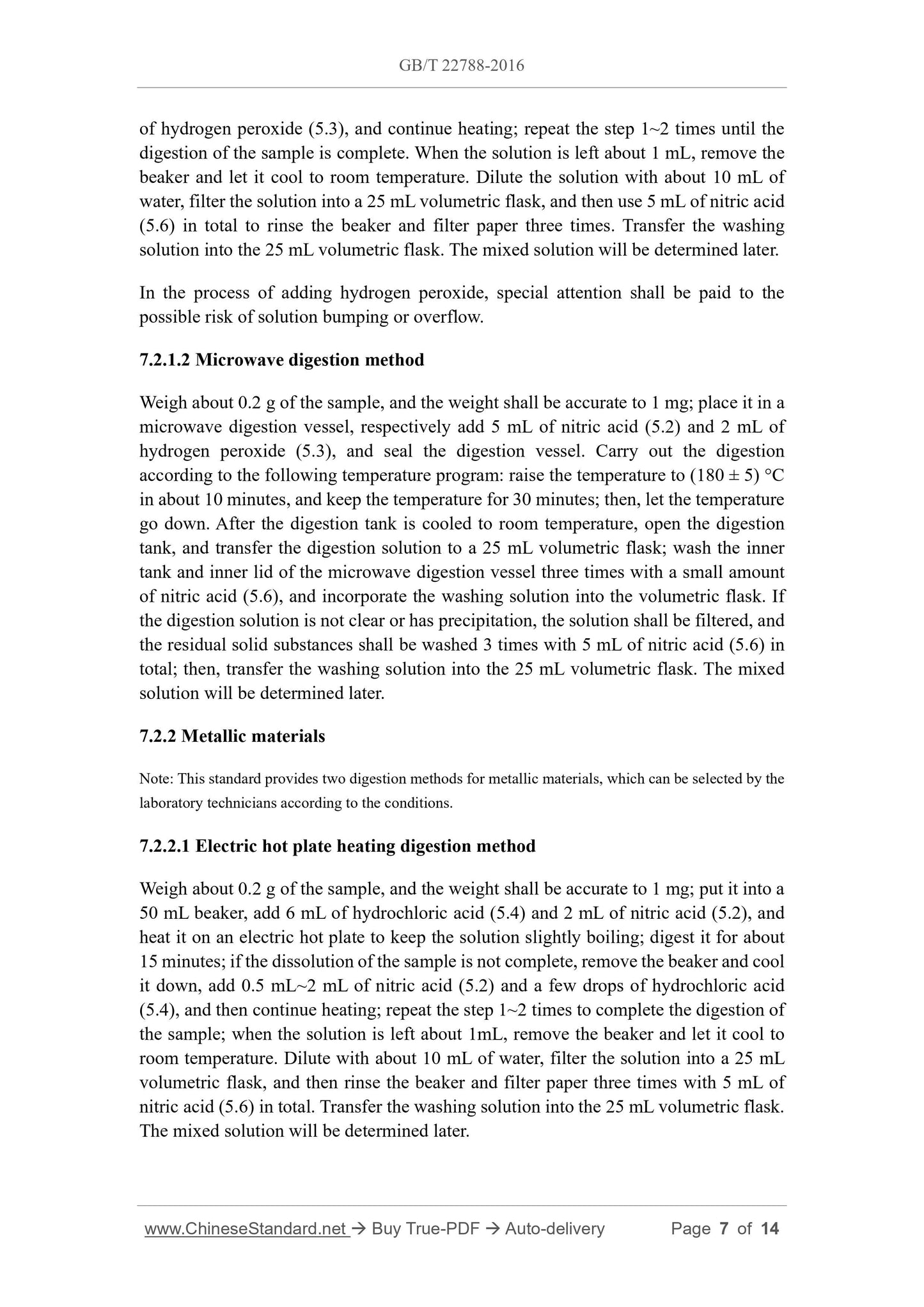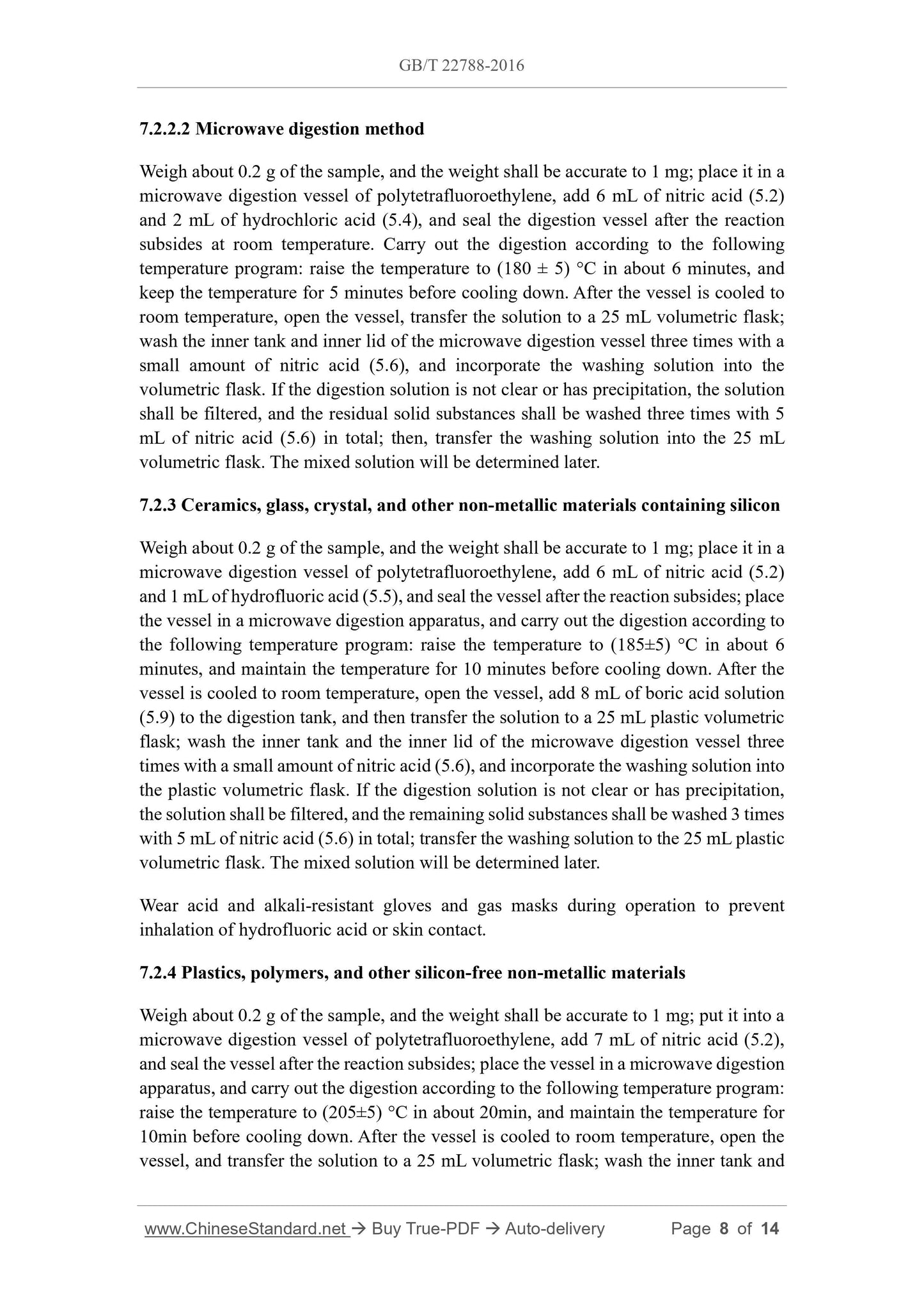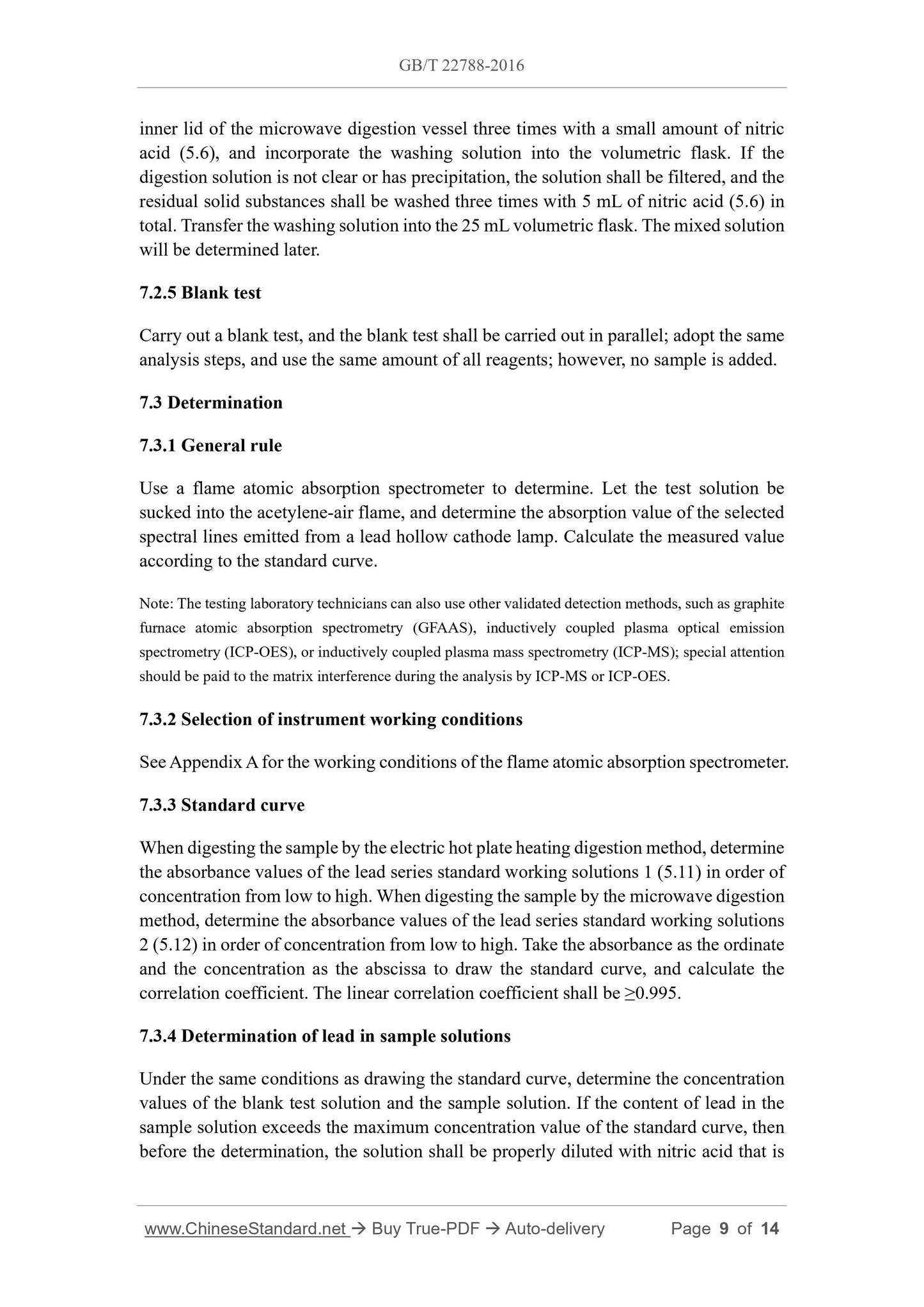1
/
of
6
www.ChineseStandard.us -- Field Test Asia Pte. Ltd.
GB/T 22788-2016 English PDF (GB/T22788-2016)
GB/T 22788-2016 English PDF (GB/T22788-2016)
Regular price
$170.00
Regular price
Sale price
$170.00
Unit price
/
per
Shipping calculated at checkout.
Couldn't load pickup availability
GB/T 22788-2016: Determination of total lead content in surface coating on toys
Delivery: 9 seconds. Download (& Email) true-PDF + Invoice.
Get Quotation: Click GB/T 22788-2016 (Self-service in 1-minute)
Historical versions (Master-website): GB/T 22788-2016
Preview True-PDF (Reload/Scroll-down if blank)
GB/T 22788-2016
NATIONAL STANDARD OF THE
PEOPLE’S REPUBLIC OF CHINA
ICS 97.200.50
Y 57
Replace GB/T 22788-2008
Determination of total lead content in material of toys and
children’s products
ISSUED ON: DECEMBER 13, 2016
IMPLEMENTED ON: JULY 1, 2017
Issued by: General Administration of Quality Supervision, Inspection and
Quarantine of PRC;
Standardization Administration of PRC.
Table of Contents
Foreword ... 3
1 Scope ... 4
2 Normative references ... 4
3 Terms and definitions ... 4
4 Principles ... 5
5 Reagents or materials ... 5
6 Instruments and equipment ... 6
7 Analysis steps ... 6
8 Calculation of results ... 10
9 Precision ... 10
10 Detection Limit of the Method ... 10
11 Test report ... 10
Appendix A (Informative) Working conditions of FAAS ... 12
Appendix B (Informative) Precision data from interlaboratory test results ... 13
References ... 14
Determination of total lead content in material of toys and
children’s products
Warning -- The personnel using this document shall have practical experience in
formal laboratory work. This document does not indicate all possible safety
issues. The user is responsible for taking appropriate safety and health measures
and ensuring compliance with the conditions stipulated by relevant national laws
and regulations.
1 Scope
This standard specifies the determination methods of total lead content in materials of
toys and children’s products.
This standard is applicable to the determination of total lead content in surface coatings,
metallic and non-metallic materials of toys and children’s products.
2 Normative references
The following documents are essential to the application of this document. For the dated
documents, only the versions with the dates indicated are applicable to this document;
for the undated documents, only the latest version (including all the amendments) is
applicable to this standard.
GB/T 602 Chemical reagent -- Preparations of standard solutions for impurity
GB/T 6379.2 Measurement methods and results -- Accuracy (trueness and precision)
-- Part 2: Determine the standard methods of measurement repeatability and
reproducibility of the basic method
GB 6675.4 Safety of toys -- Part 4: Migration of certain elements
GB/T 6682 Water for analytical laboratory use -- Specification and test methods
3 Terms and definitions
Terms and definitions defined in GB 6675.4 are applicable to this document.
of hydrogen peroxide (5.3), and continue heating; repeat the step 1~2 times until the
digestion of the sample is complete. When the solution is left about 1 mL, remove the
beaker and let it cool to room temperature. Dilute the solution with about 10 mL of
water, filter the solution into a 25 mL volumetric flask, and then use 5 mL of nitric acid
(5.6) in total to rinse the beaker and filter paper three times. Transfer the washing
solution into the 25 mL volumetric flask. The mixed solution will be determined later.
In the process of adding hydrogen peroxide, special attention shall be paid to the
possible risk of solution bumping or overflow.
7.2.1.2 Microwave digestion method
Weigh about 0.2 g of the sample, and the weight shall be accurate to 1 mg; place it in a
microwave digestion vessel, respectively add 5 mL of nitric acid (5.2) and 2 mL of
hydrogen peroxide (5.3), and seal the digestion vessel. Carry out the digestion
according to the following temperature program: raise the temperature to (180 ± 5) °C
in about 10 minutes, and keep the temperature for 30 minutes; then, let the temperature
go down. After the digestion tank is cooled to room temperature, open the digestion
tank, and transfer the digestion solution to a 25 mL volumetric flask; wash the inner
tank and inner lid of the microwave digestion vessel three times with a small amount
of nitric acid (5.6), and incorporate the washing solution into the volumetric flask. If
the digestion solution is not clear or has precipitation, the solution shall be filtered, and
the residual solid substances shall be washed 3 times with 5 mL of nitric acid (5.6) in
total; then, transfer the washing solution into the 25 mL volumetric flask. The mixed
solution will be determined later.
7.2.2 Metallic materials
Note: This standard provides two digestion methods for metallic materials, which can be selected by the
laboratory technicians according to the conditions.
7.2.2.1 Electric hot plate heating digestion method
Weigh about 0.2 g of the sample, and the weight shall be accurate to 1 mg; put it into a
50 mL beaker, add 6 mL of hydrochloric acid (5.4) and 2 mL of nitric acid (5.2), and
heat it on an electric hot plate to keep the solution slightly boiling; digest it for about
15 minutes; if the dissolution of the sample is not complete, remove the beaker and cool
it down, add 0.5 mL~2 mL of nitric acid (5.2) and a few drops of hydrochloric acid
(5.4), and then continue heating; repeat the step 1~2 times to complete the digestion of
the sample; when the solution is left about 1mL, remove the beaker and let it cool to
room temperature. Dilute with about 10 mL of water, filter the solution into a 25 mL
volumetric flask, and then rinse the beaker and filter paper three times with 5 mL of
nitric acid (5.6) in total. Transfer the washing solution into the 25 mL volumetric flask.
The mixed solution will be determined later.
7.2.2.2 Microwave digestion method
Weigh about 0.2 g of the sample, and the weight shall be accurate to 1 mg; place it in a
microwave digestion vessel of polytetrafluoroethylene, add 6 mL of nitric acid (5.2)
and 2 mL of hydrochloric acid (5.4), and seal the digestion vessel after the reaction
subsides at room temperature. Carry out the digestion according to the following
temperature program: raise the temperature to (180 ± 5) °C in about 6 minutes, and
keep the temperature for 5 minutes before cooling down. After the vessel is cooled to
room temperature, open the vessel, transfer the solution to a 25 mL volumetric flask;
wash the inner tank and inner lid of the microwave digestion vessel three times with a
small amount of nitric acid (5.6), and incorporate the washing solution into the
volumetric flask. If the digestion solution is not clear or has precipitation, the solution
shall be filtered, and the residual solid substances shall be washed three times with 5
mL of nitric acid (5.6) in total; then, transfer the washing solution into the 25 mL
volumetric flask. The mixed solution will be determined later.
7.2.3 Ceramics, glass, crystal, and other non-metallic materials containing silicon
Weigh about 0.2 g of the sample, and the weight shall be accurate to 1 mg; place it in a
microwave digestion vessel of polytetrafluoroethylene, add 6 mL of nitric acid (5.2)
and 1 mL of hydrofluoric acid (5.5), and seal the vessel after the reaction subsides; place
the vessel in a microwave digestion apparatus, and carry out the digestion according to
the following temperature program: raise the temperature to (185±5) °C in about 6
minutes, and maintain the temperature for 10 minutes before cooling down. After the
vessel is cooled to room temperature, open the vessel, add 8 mL of boric acid solution
(5.9) to the digestion tank, and then transfer the solution to a 25 mL plastic volumetric
flask; wash the inner tank and the inner lid of the microwave digestion vessel three
times with a small amount of nitric acid (5.6), and incorporate the washing solution into
the plastic volumetric flask. If the digestion solution is not clear or has precipitation,
the solution shall be filtered, and the remaining solid substances shall be washed 3 times
with 5 mL of nitric acid (5.6) in total; transfer the washing solution to the 25 mL plastic
volumetric flask. The mixed solution will be determined later.
Wear acid and alkali-resistant gloves and gas masks during operation to prevent
inhalation of hydrofluoric acid or skin contact.
7.2.4 Plastics, polymers, and other silicon-free non-metallic materials
Weigh about 0.2 g of the sample, and the weight shall be accurate to 1 mg; put it into a
microwave digestion vessel of polytetrafluoroethylene, add 7 mL of nitric acid (5.2),
and seal the vessel after the reaction subsides; place the vessel in a microwave digestion
apparatus, and carry out the digestion according to the following temperature program:
raise the temperature to (205±5) °C in about 20min, and maintain the temperature for
10min before cooling down. After the vessel is cooled to room temperature, open the
vessel, and transfer the solution to a 25 mL volumetric flask; wash the inner tank and
inner lid of the microwave digestion vessel three times with a small amount of nitric
acid (5.6), and incorporate the washing solution into the volumetric flask. If the
digestion solution is not clear or has precipitation, the solution shall be filtered, and the
residual solid substances shall be washed three times with 5 mL of nitric acid (5.6) in
total. Transfer the washing solution into the 25 mL volumetric flask. The mixed solution
will be determined later.
7.2.5 Blank test
Carry out a blank test, and the blank test shall be carried out in parallel; adopt the same
analysis steps, and use the same amount of all reagents; however, no sample is added.
7.3 Determination
7.3.1 General rule
Use a flame atomic absorption spectrometer to determine. Let the test solution be
sucked into the acetylene-air flame, and determine the absorption value of the selected
spectral lines emitted from a lead hollow cathode lamp. Calculate the measured value
according to the standard curve.
Note: The testing laboratory technicians can also use other validated detection methods, such as graphite
furnace atomic absorption spectrometry (GFAAS), inductively coupled plasma optical emission
spectrometry (ICP-OES), or inductively coupled plasma mass spectrometry (ICP-MS); special attention
should be paid to the matrix interference during the analysis by ICP-MS or ICP-OES.
7.3.2 Selection of instrument working conditions
See Appendix A for the working conditions of the flame atomic absorption spectrometer.
7.3.3 Standard curve
When digesting the sample by the electric hot plate heating digestion method, determine
the absorbance values of the lead series standard working solutions 1 (5.11) in order of
concentration from low to high. When digesting the sample by the microwave digestion
method, determine the absorbance values of the lead series standard working solutions
2 (5.12) in order of concentration from low to high. Take the absorbance as the ordinate
and the concentration as the abscissa to draw the standard curve, and calculate the
correlation coefficient. The linear correlation coefficient shall be ≥0.995.
7.3.4 Determination of lead in sample solutions
Under the same conditions as drawing the standard curve, determine the concentration
values of the blank test solution and the sample solution. If the content of lead in the
sample solution exceeds the maximum concentration value of the standard curve, then
before the determination, the solution shall be properly diluted with nitric acid that is
GB/T 22788-2016
NATIONAL STANDARD OF THE
PEOPLE’S REPUBLIC OF CHINA
ICS 97.200.50
Y 57
Replace GB/T 22788-2008
Determination of total lead content in material of toys and
children’s products
ISSUED ON: DECEMBER 13, 2016
IMPLEMENTED ON: JULY 1, 2017
Issued by: General Administration of Quality Supervision, Inspection and
Quarantine of PRC;
Standardization Administration of PRC.
Table of Contents
Foreword ... 3
1 Scope ... 4
2 Normative references ... 4
3 Terms and definitions ... 4
4 Principles ... 5
5 Reagents or materials ... 5
6 Instruments and equipment ... 6
7 Analysis steps ... 6
8 Calculation of results ... 10
9 Precision ... 10
10 Detection Limit of the Method ... 10
11 Test report ... 10
Appendix A (Informative) Working conditions of FAAS ... 12
Appendix B (Informative) Precision data from interlaboratory test results ... 13
References ... 14
Determination of total lead content in material of toys and
children’s products
Warning -- The personnel using this document shall have practical experience in
formal laboratory work. This document does not indicate all possible safety
issues. The user is responsible for taking appropriate safety and health measures
and ensuring compliance with the conditions stipulated by relevant national laws
and regulations.
1 Scope
This standard specifies the determination methods of total lead content in materials of
toys and children’s products.
This standard is applicable to the determination of total lead content in surface coatings,
metallic and non-metallic materials of toys and children’s products.
2 Normative references
The following documents are essential to the application of this document. For the dated
documents, only the versions with the dates indicated are applicable to this document;
for the undated documents, only the latest version (including all the amendments) is
applicable to this standard.
GB/T 602 Chemical reagent -- Preparations of standard solutions for impurity
GB/T 6379.2 Measurement methods and results -- Accuracy (trueness and precision)
-- Part 2: Determine the standard methods of measurement repeatability and
reproducibility of the basic method
GB 6675.4 Safety of toys -- Part 4: Migration of certain elements
GB/T 6682 Water for analytical laboratory use -- Specification and test methods
3 Terms and definitions
Terms and definitions defined in GB 6675.4 are applicable to this document.
of hydrogen peroxide (5.3), and continue heating; repeat the step 1~2 times until the
digestion of the sample is complete. When the solution is left about 1 mL, remove the
beaker and let it cool to room temperature. Dilute the solution with about 10 mL of
water, filter the solution into a 25 mL volumetric flask, and then use 5 mL of nitric acid
(5.6) in total to rinse the beaker and filter paper three times. Transfer the washing
solu...
Delivery: 9 seconds. Download (& Email) true-PDF + Invoice.
Get Quotation: Click GB/T 22788-2016 (Self-service in 1-minute)
Historical versions (Master-website): GB/T 22788-2016
Preview True-PDF (Reload/Scroll-down if blank)
GB/T 22788-2016
NATIONAL STANDARD OF THE
PEOPLE’S REPUBLIC OF CHINA
ICS 97.200.50
Y 57
Replace GB/T 22788-2008
Determination of total lead content in material of toys and
children’s products
ISSUED ON: DECEMBER 13, 2016
IMPLEMENTED ON: JULY 1, 2017
Issued by: General Administration of Quality Supervision, Inspection and
Quarantine of PRC;
Standardization Administration of PRC.
Table of Contents
Foreword ... 3
1 Scope ... 4
2 Normative references ... 4
3 Terms and definitions ... 4
4 Principles ... 5
5 Reagents or materials ... 5
6 Instruments and equipment ... 6
7 Analysis steps ... 6
8 Calculation of results ... 10
9 Precision ... 10
10 Detection Limit of the Method ... 10
11 Test report ... 10
Appendix A (Informative) Working conditions of FAAS ... 12
Appendix B (Informative) Precision data from interlaboratory test results ... 13
References ... 14
Determination of total lead content in material of toys and
children’s products
Warning -- The personnel using this document shall have practical experience in
formal laboratory work. This document does not indicate all possible safety
issues. The user is responsible for taking appropriate safety and health measures
and ensuring compliance with the conditions stipulated by relevant national laws
and regulations.
1 Scope
This standard specifies the determination methods of total lead content in materials of
toys and children’s products.
This standard is applicable to the determination of total lead content in surface coatings,
metallic and non-metallic materials of toys and children’s products.
2 Normative references
The following documents are essential to the application of this document. For the dated
documents, only the versions with the dates indicated are applicable to this document;
for the undated documents, only the latest version (including all the amendments) is
applicable to this standard.
GB/T 602 Chemical reagent -- Preparations of standard solutions for impurity
GB/T 6379.2 Measurement methods and results -- Accuracy (trueness and precision)
-- Part 2: Determine the standard methods of measurement repeatability and
reproducibility of the basic method
GB 6675.4 Safety of toys -- Part 4: Migration of certain elements
GB/T 6682 Water for analytical laboratory use -- Specification and test methods
3 Terms and definitions
Terms and definitions defined in GB 6675.4 are applicable to this document.
of hydrogen peroxide (5.3), and continue heating; repeat the step 1~2 times until the
digestion of the sample is complete. When the solution is left about 1 mL, remove the
beaker and let it cool to room temperature. Dilute the solution with about 10 mL of
water, filter the solution into a 25 mL volumetric flask, and then use 5 mL of nitric acid
(5.6) in total to rinse the beaker and filter paper three times. Transfer the washing
solution into the 25 mL volumetric flask. The mixed solution will be determined later.
In the process of adding hydrogen peroxide, special attention shall be paid to the
possible risk of solution bumping or overflow.
7.2.1.2 Microwave digestion method
Weigh about 0.2 g of the sample, and the weight shall be accurate to 1 mg; place it in a
microwave digestion vessel, respectively add 5 mL of nitric acid (5.2) and 2 mL of
hydrogen peroxide (5.3), and seal the digestion vessel. Carry out the digestion
according to the following temperature program: raise the temperature to (180 ± 5) °C
in about 10 minutes, and keep the temperature for 30 minutes; then, let the temperature
go down. After the digestion tank is cooled to room temperature, open the digestion
tank, and transfer the digestion solution to a 25 mL volumetric flask; wash the inner
tank and inner lid of the microwave digestion vessel three times with a small amount
of nitric acid (5.6), and incorporate the washing solution into the volumetric flask. If
the digestion solution is not clear or has precipitation, the solution shall be filtered, and
the residual solid substances shall be washed 3 times with 5 mL of nitric acid (5.6) in
total; then, transfer the washing solution into the 25 mL volumetric flask. The mixed
solution will be determined later.
7.2.2 Metallic materials
Note: This standard provides two digestion methods for metallic materials, which can be selected by the
laboratory technicians according to the conditions.
7.2.2.1 Electric hot plate heating digestion method
Weigh about 0.2 g of the sample, and the weight shall be accurate to 1 mg; put it into a
50 mL beaker, add 6 mL of hydrochloric acid (5.4) and 2 mL of nitric acid (5.2), and
heat it on an electric hot plate to keep the solution slightly boiling; digest it for about
15 minutes; if the dissolution of the sample is not complete, remove the beaker and cool
it down, add 0.5 mL~2 mL of nitric acid (5.2) and a few drops of hydrochloric acid
(5.4), and then continue heating; repeat the step 1~2 times to complete the digestion of
the sample; when the solution is left about 1mL, remove the beaker and let it cool to
room temperature. Dilute with about 10 mL of water, filter the solution into a 25 mL
volumetric flask, and then rinse the beaker and filter paper three times with 5 mL of
nitric acid (5.6) in total. Transfer the washing solution into the 25 mL volumetric flask.
The mixed solution will be determined later.
7.2.2.2 Microwave digestion method
Weigh about 0.2 g of the sample, and the weight shall be accurate to 1 mg; place it in a
microwave digestion vessel of polytetrafluoroethylene, add 6 mL of nitric acid (5.2)
and 2 mL of hydrochloric acid (5.4), and seal the digestion vessel after the reaction
subsides at room temperature. Carry out the digestion according to the following
temperature program: raise the temperature to (180 ± 5) °C in about 6 minutes, and
keep the temperature for 5 minutes before cooling down. After the vessel is cooled to
room temperature, open the vessel, transfer the solution to a 25 mL volumetric flask;
wash the inner tank and inner lid of the microwave digestion vessel three times with a
small amount of nitric acid (5.6), and incorporate the washing solution into the
volumetric flask. If the digestion solution is not clear or has precipitation, the solution
shall be filtered, and the residual solid substances shall be washed three times with 5
mL of nitric acid (5.6) in total; then, transfer the washing solution into the 25 mL
volumetric flask. The mixed solution will be determined later.
7.2.3 Ceramics, glass, crystal, and other non-metallic materials containing silicon
Weigh about 0.2 g of the sample, and the weight shall be accurate to 1 mg; place it in a
microwave digestion vessel of polytetrafluoroethylene, add 6 mL of nitric acid (5.2)
and 1 mL of hydrofluoric acid (5.5), and seal the vessel after the reaction subsides; place
the vessel in a microwave digestion apparatus, and carry out the digestion according to
the following temperature program: raise the temperature to (185±5) °C in about 6
minutes, and maintain the temperature for 10 minutes before cooling down. After the
vessel is cooled to room temperature, open the vessel, add 8 mL of boric acid solution
(5.9) to the digestion tank, and then transfer the solution to a 25 mL plastic volumetric
flask; wash the inner tank and the inner lid of the microwave digestion vessel three
times with a small amount of nitric acid (5.6), and incorporate the washing solution into
the plastic volumetric flask. If the digestion solution is not clear or has precipitation,
the solution shall be filtered, and the remaining solid substances shall be washed 3 times
with 5 mL of nitric acid (5.6) in total; transfer the washing solution to the 25 mL plastic
volumetric flask. The mixed solution will be determined later.
Wear acid and alkali-resistant gloves and gas masks during operation to prevent
inhalation of hydrofluoric acid or skin contact.
7.2.4 Plastics, polymers, and other silicon-free non-metallic materials
Weigh about 0.2 g of the sample, and the weight shall be accurate to 1 mg; put it into a
microwave digestion vessel of polytetrafluoroethylene, add 7 mL of nitric acid (5.2),
and seal the vessel after the reaction subsides; place the vessel in a microwave digestion
apparatus, and carry out the digestion according to the following temperature program:
raise the temperature to (205±5) °C in about 20min, and maintain the temperature for
10min before cooling down. After the vessel is cooled to room temperature, open the
vessel, and transfer the solution to a 25 mL volumetric flask; wash the inner tank and
inner lid of the microwave digestion vessel three times with a small amount of nitric
acid (5.6), and incorporate the washing solution into the volumetric flask. If the
digestion solution is not clear or has precipitation, the solution shall be filtered, and the
residual solid substances shall be washed three times with 5 mL of nitric acid (5.6) in
total. Transfer the washing solution into the 25 mL volumetric flask. The mixed solution
will be determined later.
7.2.5 Blank test
Carry out a blank test, and the blank test shall be carried out in parallel; adopt the same
analysis steps, and use the same amount of all reagents; however, no sample is added.
7.3 Determination
7.3.1 General rule
Use a flame atomic absorption spectrometer to determine. Let the test solution be
sucked into the acetylene-air flame, and determine the absorption value of the selected
spectral lines emitted from a lead hollow cathode lamp. Calculate the measured value
according to the standard curve.
Note: The testing laboratory technicians can also use other validated detection methods, such as graphite
furnace atomic absorption spectrometry (GFAAS), inductively coupled plasma optical emission
spectrometry (ICP-OES), or inductively coupled plasma mass spectrometry (ICP-MS); special attention
should be paid to the matrix interference during the analysis by ICP-MS or ICP-OES.
7.3.2 Selection of instrument working conditions
See Appendix A for the working conditions of the flame atomic absorption spectrometer.
7.3.3 Standard curve
When digesting the sample by the electric hot plate heating digestion method, determine
the absorbance values of the lead series standard working solutions 1 (5.11) in order of
concentration from low to high. When digesting the sample by the microwave digestion
method, determine the absorbance values of the lead series standard working solutions
2 (5.12) in order of concentration from low to high. Take the absorbance as the ordinate
and the concentration as the abscissa to draw the standard curve, and calculate the
correlation coefficient. The linear correlation coefficient shall be ≥0.995.
7.3.4 Determination of lead in sample solutions
Under the same conditions as drawing the standard curve, determine the concentration
values of the blank test solution and the sample solution. If the content of lead in the
sample solution exceeds the maximum concentration value of the standard curve, then
before the determination, the solution shall be properly diluted with nitric acid that is
GB/T 22788-2016
NATIONAL STANDARD OF THE
PEOPLE’S REPUBLIC OF CHINA
ICS 97.200.50
Y 57
Replace GB/T 22788-2008
Determination of total lead content in material of toys and
children’s products
ISSUED ON: DECEMBER 13, 2016
IMPLEMENTED ON: JULY 1, 2017
Issued by: General Administration of Quality Supervision, Inspection and
Quarantine of PRC;
Standardization Administration of PRC.
Table of Contents
Foreword ... 3
1 Scope ... 4
2 Normative references ... 4
3 Terms and definitions ... 4
4 Principles ... 5
5 Reagents or materials ... 5
6 Instruments and equipment ... 6
7 Analysis steps ... 6
8 Calculation of results ... 10
9 Precision ... 10
10 Detection Limit of the Method ... 10
11 Test report ... 10
Appendix A (Informative) Working conditions of FAAS ... 12
Appendix B (Informative) Precision data from interlaboratory test results ... 13
References ... 14
Determination of total lead content in material of toys and
children’s products
Warning -- The personnel using this document shall have practical experience in
formal laboratory work. This document does not indicate all possible safety
issues. The user is responsible for taking appropriate safety and health measures
and ensuring compliance with the conditions stipulated by relevant national laws
and regulations.
1 Scope
This standard specifies the determination methods of total lead content in materials of
toys and children’s products.
This standard is applicable to the determination of total lead content in surface coatings,
metallic and non-metallic materials of toys and children’s products.
2 Normative references
The following documents are essential to the application of this document. For the dated
documents, only the versions with the dates indicated are applicable to this document;
for the undated documents, only the latest version (including all the amendments) is
applicable to this standard.
GB/T 602 Chemical reagent -- Preparations of standard solutions for impurity
GB/T 6379.2 Measurement methods and results -- Accuracy (trueness and precision)
-- Part 2: Determine the standard methods of measurement repeatability and
reproducibility of the basic method
GB 6675.4 Safety of toys -- Part 4: Migration of certain elements
GB/T 6682 Water for analytical laboratory use -- Specification and test methods
3 Terms and definitions
Terms and definitions defined in GB 6675.4 are applicable to this document.
of hydrogen peroxide (5.3), and continue heating; repeat the step 1~2 times until the
digestion of the sample is complete. When the solution is left about 1 mL, remove the
beaker and let it cool to room temperature. Dilute the solution with about 10 mL of
water, filter the solution into a 25 mL volumetric flask, and then use 5 mL of nitric acid
(5.6) in total to rinse the beaker and filter paper three times. Transfer the washing
solu...
Share
